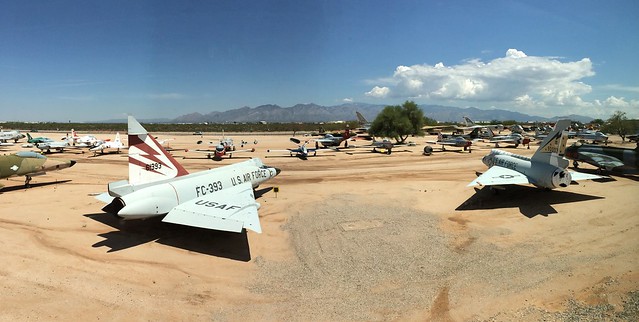Pima Air and Space Museum announced today it’s eliminating the walking tour program. These were volunteer-led tours of aircraft on display inside PASM’s exhibit hangars, free to museum visitors. I was a walking tour docent and team leader from 2011 to 2015, my first four years there, and always enjoyed the interaction with museum visitors. These days I’m a tram docent, taking visitors on tours of the outdoor aircraft displayed on PASM’s grounds. The fun of interacting with visitors and answering their questions is the same, but there’s a difference: visitors have to buy an extra ticket to ride on the tram, so for the past four years I’ve actually been helping the museum stay afloat financially.

So far this year the museum has eliminated three sets of volunteers. First to go were the greeters, the men and women who met arriving visitors at the museum entrance, handed out guides, and told guests where different aircraft are displayed and how to get there. As of today, the walking tour docents have likewise been cut loose. In between were the Boneyard tour guides, the team of a dozen volunteers who narrated bus tours of the 4,000-odd military aircraft in storage at the nearby 309th Aerospace Maintenance and Regeneration Group, who have been replaced by three full-time salaried tour guides.
A cynic would observe that greeters and free walking tours didn’t make money for the museum. True, but the Boneyard tours do, and so do the tram tours, both of which visitors pay extra for. So I can’t help wondering why the museum would get rid of a dozen unpaid expert tour guides and replace them with paid workers, because now the museum is making less money off those tours than before. Then again, maybe the cost has been factored in and they’re charging more for Boneyard tickets.

When I first mentioned the plan to replace Boneyard volunteers with paid tour guides, I wondered if museum staff might be considering something similar for the tram tours. Our team of volunteers, each of whom come in one day a week, could be replaced with two, maybe three paid full-timers. The museum could probably get away with hiring minimum-wage workers: do they really need our experience and knowledge when they could simply play a taped narration over the tram speakers and instruct the new drivers to keep up with the spiel?
When I got this morning’s mass email announcing the end of the walking tour program, I replied to the staffer who sent it, asking if my fellow tram docents and I still have a future at the museum. She responded, assuring me we do. Her reply didn’t deliver the intended warm & fuzzy, but since I still like what I’m doing at PASM, especially the interaction with museum visitors, I’ll keep plugging away. But something’s going on, and I won’t be surprised … disappointed, yes, but not surprised … if my days at Pima Air and Space Museum turn out to be numbered.
Over the past two years I’ve sensed a growing antipathy from museum staff toward the volunteers who work with visitors (as far as I know, this antipathy doesn’t apply to the hundred or so volunteers who work behind the scenes in aircraft restoration). I don’t know exactly where it’s coming from, whether it’s just one person on the staff or several, and I certainly don’t know enough to point fingers. It’s definitely there, though, and I’m far from the only volunteer to feel it. How else to explain replacing free labor with paid labor?
I don’t claim to know anything about the museum business, but I go to other air museums every chance I get, and have yet to visit one that doesn’t rely on large numbers of unpaid volunteers to interact with guests. That gives me hope for a future at PASM after all. We’ll see.
Well said Paul…as a former Boneyard docent I share your thoughts on this subject. My additional belief is that there is an effort in control (command and control). In my five years, the museum staff has never valued input from the direct line in customer service…the volunteers. To trust a volunteer with a bus load of visitors on tour of a military base, just left the staff “out of control.” Now with paid docents…they will be controlled and must do as they are told. I think a problem for the future of PASM is the lack of understanding the museum’s customer and what they really expect. As docents we have been to many museums and know how we have been greeted, guided, educated and rewarded by the experience. At PASM it is becoming at walk through a large collection of airplanes…quantity over quality of experience.